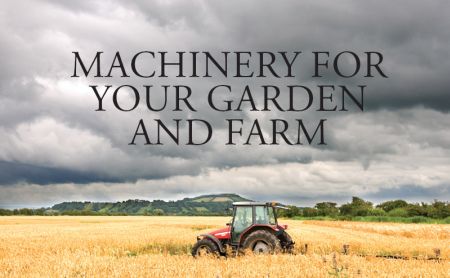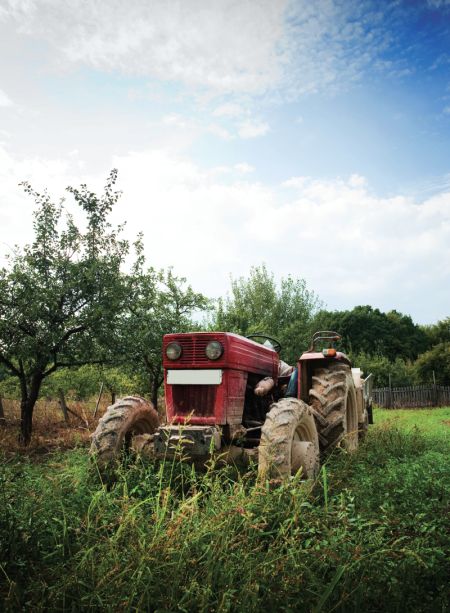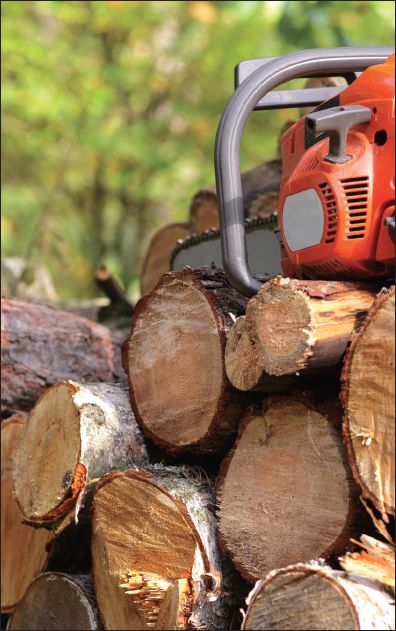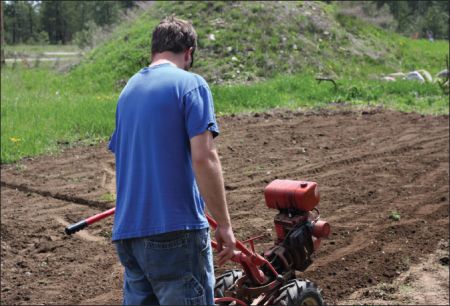
Though farmers got along for millennia without such luxuries, there are some basic farm tools that will make living off the land much easier and more productive for you. Choose your machinery carefully—you don’t need every fancy toy that comes on the market, nor should you spend good money on a poorly-maintained old tractor that’s going to fall apart on you first circle around the field. If you’re not in desperate need of the machinery, take your time to look around at both new and used options before making any purchases.
Buying a Tractor
First, make sure it is definitely a tractor that you need, and not a similar tool such as a skid steer loader, mini excavator, or backhoe. If you need a machine which has numerous uses and the ability to interact with many kinds of attachments, a tractor is a smart choice. Tractors also offer limited surface impact, so for any work which requires interaction with grass or loose surfaces, a tractor is your best bet. Consider the type of surface the tractor will be used on, the elevation of the land, the weather conditions of your area, the attachments you will use, and the distance the tractor must be able to travel.
Horsepower is the next important factor in determining the tractor model which will work best for you. A tractor’s horsepower is what determines the amount of work it will be able to perform, and also how much you will pay. Typically, tractors with between 25 to 65 horsepower are a comfortable middle ground when it comes to tractor performance. Anything below 25 is for the most basic, least strenuous work, and above 65 is capable of handling heavier agricultural work (tilling fields, baling hay, etc). For most uses, a tractor with a wide front end—instead of a tricycle front end—is safer and more durable.
Depending on your needs, you might want a tractor with a power take-off (PTO) and 3-point hitch. One hydraulic hook-up is sufficient, although more are nice. If the tractor comes with a drawbar with the 3-point hitch, that’s great, as those are expensive. Also, if available, you want to get as many weights as possible for the tractor. Weights that fit your tractor are often in high demand. Liquid filled tires are an optional means of adding weight, but the fluid in many of these older tractors is corrosive, so look for possible bad wheel rims. And because of the high cost of new tractor tires, you want very solid tires.
Most new tractors are 4WD, and are generally a better option than 2WD. A 4WD tractor allows for the attachment of a front loader, and also typically have a higher resale value than those with 2WD. On surfaces with poor traction— mud, snow, gravel—the 4WD tractor is definitely the better option. The only situation in which a 2WD tractor may be more beneficial is for basic mowing.
Enclosed cabs do not come standard with all tractors, but are incredibly beneficial for anyone who will be using the tractor in cold weather or under extreme sun. Although tractors with enclosed cabs will cost more, their resale value will also be higher.
Most older tractors will have manual transmissions, whereas hydrostatic transmission has emerged as a popular alternative in newer models for those who are uncomfortable with manual transmission.
The tires that you choose to purchase for your tractor will depend upon the work that your tractor will be doing, Agricultural tires, industrial tires, or turf tires are all tire options which pertain to certain kinds of work.
There are a number of tractor attachments, all of which are geared toward performing a certain task. Box blades, mowers, tillers, plows, backhoes, landscape rakes, spreaders, forks, grapples, and hay bailers are all possible attachments which may be used with your trailer.
Tractor Manufacturers:
Ag-Chem Equipment–www.agchem.com
AGCO–www.agcocorp.com
Ariens–www.ariens.com
B and H Manufacturing–www.bhmfg.com
Batco–www.batcomfg.com
Bobcat–www.bobcat.com
Briggs & tratton–www.briggsandstratton.com
Brillion–www.brillionfarmeq.com
Bush Hog–www.bushhog.com
Crary–www.crary.com
Cub Cadet–www.mtdproducts.com
Caterpillar–www.cat.com
Fendt–www.fendt.com
Flexi-Coil–www.flexicoil.com
Gehl–www.gehl.com
Hagie Manufacturing–www.hagie.com
JCB–www.jcb.co.uk
John Deere–www.deere.com
Landoll–www.landoll.com
Leon Manufacturing–www.leonsmfg.com
Redrock Engineering–www.redrock-engineering.com
Schulte Manufacturing–www.pima.ca/members/Schulte .html
Shelbourne Reynolds–www.shelbourne.com
Lawn Mowers
There are two basic types of lawn mowers: reel and rotary mowers. Rotary mowers include hand-pushed, self-propelled, and riding mowers. Hand-pushed rotary mowers are suitable for lawns which are relatively small on level ground, but for lawns which are bigger or hilly, a self-propelled rotary mower may be the better choice. Lawns are that are large— an acre or more— often call for a riding rotary mower, which functions much like a tractor. The operator sits on top of the mower to steer and power the device, so the physical strain is significantly less than both other rotary mowers. Riding mowers are more costly than the others, and also take up more storage space.
Reel lawn mowers are comprised of a set of blades on a revolving cylinder. The cylinder moves as the mower is pushed forward, causing the blades to revolve and cut. These mowers require the operator to both push and propel movement, and can also be high-maintenance, as the blades require sharpening. However, they offer the closest cut of all the different kinds of mowers Rotary lawn mowers use a flat, horizontal blade which rotates in a circular motion, which often does not give a close nor as clean a cut as a reel mower, but they’re much easier to use.
For a “greener” option, you may want to consider using an electric powered lawn mower instead of a gas powered device. Electric mowers are available in both reel and rotary designs, and are quieter than gas powered alternatives.
When deciding what kind of lawn mower to buy, it is important to consider a number of factors. The size of your lawn, your budget, and what you need your mower to do. If you have a small lawn with a lot of shrubs, for example, you are not going to want a riding mower, which takes up a lot of room and does not have a great turning radius. Once you determine exactly what kind of mower would address your needs, it’s time to shop around and determine which model or brand is your best fit.

Lawn Mower Manufacturers:
Honda–www.hondapowerequipment.com/products /Lawnmowers
Toro—www.toro.com
John Deere–www.deere.com/en_US/homeowners/index.html
Craftsman–www.craftsman.com
Lawn-Boy–www.lawn-boy.com
Cub Cadet–www.cubcadet.com
Troy-Bilt–www.troybilt.com
Husqvarna–www.husqvarna.com/us/homeowner/home
Chain Saws
There are two basic kinds of chain saws: gas or electric powered. Both types have certain advantages and disadvantages, all which must be taken into account when deciding which kind will be best for you. Gasoline-powered chain saws are noisy, require mixing of oil and gas, and must be started with a pull cord. However, they are easily mobile and are capable of a great amount of power. Electric saws, on the other hand, are quieter, lighter, and easier to start than the gas-powered alternative. However, since they require electricity, they are much lest mobile than the cordless gas-powered saw, and do not offer as much power.
The kind of chainsaw that would work best for you depends upon what kind of work needs to be done. If you have area that needs clearing but won’t require heavy maintenance, an electric chain saw would probably suit you well. However, a large area with lots of thick branches would need a gas chain saw to really get the job done.
When purchasing your chain saw, you also have to keep in mind the physical exertion that will be required to yield the saw. Although a big, heavy saw will give you a lot of power with which to cut through heavy branches and shrubbery, if you are not physically capable of maintaining the saw for a long time the work will not get done.
Many modern saws come with a lot of different options and extras that can really help you safely and efficiently operate your saw. Anti-vibration technology, automatic chain oilers, quick-start electronic ignition, mufflers, and quick-adjust chains are just some of the additions that make life a little bit easier for chain saw operators.

If you need a chain saw for a quick backyard fix but do not anticipate on using it again, renting a saw is always a good option. There are a lot of resource on the internet which can help you find a local business that rents out different kinds of tools.
Chain Saw brands:
Husqvarna—www.husqvarna.com
Stihl—www.stihlusa.com
Jonsered—www.jonsered.com
ECho—www.echo-usa.com
Dolmzr—www.dolmarpowerproducts.com
Rototillers
The rotating blades of a rototiller loosen and agitate soil, preparing it for planting and fertilization. There are two standard kinds of rotary blades: counter rotating tines and standard rotating tines. Counter rotating tines are capable of producing deep holes, while standard rotating tines typically create shallower holes.
Rototillers come in all shapes and sizes, ranging from very large tractor attachments to hand-held devices. As with many garden tools, rototillers can be either gas or electric powered. Gas-powered devices typically offer the user more power, but the electric model is generally less expensive and quieter.
The kind of rototiller that you should buy depends on the size of your garden; as with other tools, the cost and strength of a rototiller increases as its horsepower goes up. If you are a homeowner with a small garden, a large horsepower tiller is unnecessary; in that same regard, if your garden is expansive a larger, more powerful model would be better. As with the chain saw, a rototiller is not a necessary purchase if you only plan on using it once or twice, and can be rented instead of bought.
